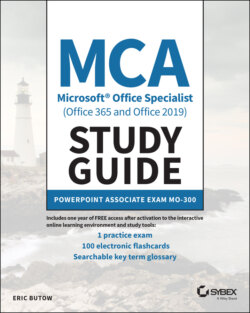Читать книгу MCA Microsoft Office Specialist (Office 365 and Office 2019) Study Guide - Eric Butow - Страница 22
Answers to Assessment Test
Оглавление1 B. You add a bulleted or numbered list using the tools in the Home ribbon. See Chapter 3 for more information.
2 C. Select Reuse Slides from the bottom of the drop‐down list to select a slide from another slideshow to insert into your slideshow. See Chapter 2 for more information.
3 A, D. You can add motion paths to animate an object within a slide and use the Morph feature to animate objects between slides. See Chapter 5 for more information.
4 C. You can add a row above or below a selected table cell, as well as a column to the left or right of the selected cell. See Chapter 4 for more information.
5 D. When you want to add information into a specific slide, you click in the appropriate placeholder area, such as the area for the slide title, and then add your text and/or object(s). See Chapter 1 for more information.
6 A, B, D. PowerPoint allows you to add various types of links, including to an email address, website, and another slide within your slideshow. See Chapter 3 for more information.
7 A, C. You can add a date and time and slide number, and you can also choose not to show the footer on the title slide in a slideshow. See Chapter 2 for more information.
8 C. Click the Insert icon to add a SmartArt graphic in the Illustrations section in the Insert ribbon. See Chapter 4 for more information.
9 C. The Slide Sorter view shows thumbnail‐sized images of all slides in your slideshow for your review. See Chapter 1 for more information.
10 A, C. You can add audio and video MPEG files, WAV audio files, and many other audio and video file formats. See Chapter 4 for more information.
11 A, C. You can insert images from Office.com, PowerPoint stock images, and images stored on your computer. See Chapter 3 for more information.
12 A, B, D. You can animate text, 3D models, and SmartArt graphics in a slide. See Chapter 5 for more information.
13 C. Print a document by clicking the File menu option and then clicking Print in the menu on the left side of the File screen. See Chapter 1 for more information.
14 B, C. You can move one or multiple slides as well as all slides in a section. See Chapter 2 for more information.
15 C. A transition is the effect that happens when the slideshow moves from one slide to another. See Chapter 5 for more information.
16 A, B, D. You can convert text to a SmartArt graphic, change the text direction, and change the text alignment. See Chapter 3 for more information.
17 B, D. You can press Ctrl+Z or click the Undo icon in the Quick Access Toolbar. See Chapter 2 for more information.
18 B, C. You can change the legend, view gridlines, and modify many other elements in a chart. See Chapter 4 for more information.
19 C. After you select the After check box in the Transitions ribbon, you can set the time for each slide transition. See Chapter 5 for more information.
20 B, D. You can get visual cues of where PowerPoint places objects in a slide with gridlines, guides, and rulers. See Chapter 3 for more information.
21 C. After you add a transition, click Effect Options in the Transitions ribbon to view all effects that you can set for that transition. See Chapter 5 for more information.
22 A, C. You can create a simple custom slideshow that you create for a specific audience, as well as a hyperlinked slideshow that contains links to custom slides for different audiences. See Chapter 1 for more information.
23 B, C. When you add 3D models in the Illustrations section in the Insert ribbon, you can add stock models installed with PowerPoint or 3D models stored on your computer. See Chapter 4 for more information.
24 D. You modify the order from within the list of thumbnail‐sized slides in the left pane. See Chapter 2 for more information.
25 A, D. PowerPoint allows you to mark a slideshow as final and add a password to your slideshow file. The latter is more effective at keeping reviewers from editing your presentation. See Chapter 1 for more information.
